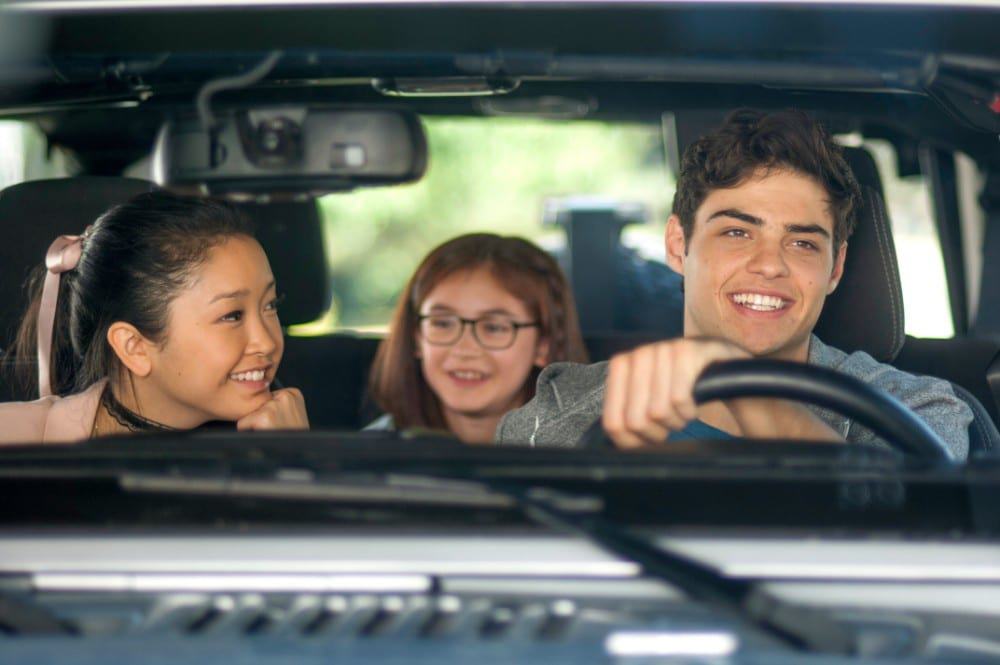
There’s a scene in the new Netflix Original movie To All The Boys I’ve Loved Before where our nervous young hero, Lara Jean (Lana Condor), almost backs her car into a classmate in her school’s parking lot. Clearly mortified after the boy confronts her about it, she stops the car and tightly grips the wheel despite the vehicle’s inertia. “What are we waiting for?” her little sister asks. “We’re waiting for the rest of the cars to leave,” Lara Jean answers.
Lara Jean Covey is very afraid of driving. She’s also afraid of kissing, dating, her former-friend-turned-bully, disappointing her sisters, and telling basically anyone around her how she actually feels about anything. Her fears are secondary to her intelligence, hidden romantic streak, and love for her family, but they’re present nonetheless. Her fears are on some level the true antagonist of Susan Johnson’s endearing adaptation of the book of the same name.
“It’s like driving,” Lara Jean later says about love. “I can imagine myself doing it and it’s fine but then I get behind the wheel and I completely freeze up, and then I just don’t know what to do.” When pushed outside of her comfort zone–which at the beginning of the movie, is quite small–Lara Jean’s immediate and consistent response is, “I can’t.”
Kayla Day (Elsie Fisher), the already beloved protagonist of Bo Burnham’s excellent feature debut Eighth Grade and another markedly shy girl, puts it another way: “I’m really, like, nervous all the time. I try really hard not to feel that way.” Kayla does try: from early in the movie, she puts herself out there, again and again, facing her social anxieties and the rejection and disappointment that often follow. While Lara Jean naturally responds to fear with planned limitations, Kayla responds with planned boundary-pushing. Both have no mother present, making their journeys to womanhood feel (for them) even more unpredictable and worrisome.
For a long time, the unstated rules of teen movies have dictated that shy, awkward, and anxious girls be either relegated to the role of a punchline (think Lilly, the girl in Pitch Perfect who barely makes a peep) or forced to undergo a dramatic transformation, to “come out of her shell” in a way that’s largely based on a physical makeover and pleases the other characters first and foremost (like Mia from The Princess Diaries).

No character embodies the nervous, shy girl makeover more clearly than Ally Sheedy’s character in The Breakfast Club. While her male counterpart in anxiety in the John Hughes universe, Ferris Bueller’s Cameron, gets to face his fears in an empowering climax-stealing monologue that’s an epic day in the making, quiet, emotional Allison (Sheedy) gets a random makeover that leaves her unrecognizable. Her fears of being ignored and of growing up are never resolved, and her only resolution is a kiss from a boy.
Even outside the realm of the shy girls, the female transformation trope has long since been a rite of passage in teen movies. It often feels like a short-cut, a way to signify character growth without actually earning or showing it. These two new movies not only subvert the shy girl trope by centering their anxiety-ridden characters as protagonists rather than supporting characters but also cast them as the heroes of their own narratives without requiring them to undergo massive personality overhauls or faux-deep makeovers.
In fact, Kayla and Lara Jean don’t change much at all over the course of their respective films. As played by Elsie Fisher, Kayla is from the beginning almost endlessly hopeful despite her constant micro-expressions of mortification and distress. Lana Condor lends Lara Jean a palpable sense of nervous energy that settles immediately when she’s with people she trusts. Instead of transforming, the characters ultimately find support where it’s always been–with their families, and with friends they’ve overlooked–and gain an inch of confidence by facing their fears in small ways (which, inevitably, to them feel like big ways) and on their own steady timelines.

There’s no single dramatic moment of clarity that helps either of these girls climb out of the holes their anxieties have dug for them. All there is is the hardscrabble day-by-day existence of adolescence, and the way each of these two unique characters chooses to deal with it. This sort of invisible character arc, during which the changes that occur to our protagonists are largely internal and possibly not even permanent, is easy to miss but should be recognized. Quietly but radically, these stories reflect real girls the world over who–with the inescapable nature of social media, also addressed by both movies–are dealing with more constant pressure to get womanhood right than any other generation.
Despite their nerves and neuroses, the girls at the heart of these two movies are never framed as anything less than heroines. During a climactic scene of To All The Boys I’ve Loved Before, Lara Jean parks her car crooked across several parking spots, but she barely notices because she’s so proud that she drove–and so are we. In Eighth Grade, Kayla Day triumphs by standing up for herself to popular girls who don’t care and barely listen, but audiences cheer when she walks away, her ever-nervous expression briefly replaced with a look of satisfaction. The wins in these movies are objectively small but framed by filmmakers who finally recognize the underappreciated power of shy girls, they feel like everything.
Related Topics: Eighth Grade, the breakfast club

